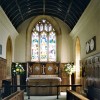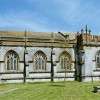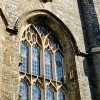Peel back the patina of a century of modernity and you will find in Iwerne Minster – the village and the parish – much to interest those of us curious about bygone times and Dorset ways. Here is one of only three churches in the county that can boast a medieval spire, here is a large country house and curiosities, and here lived some people deserving of our remembrance.
Equal distance of about six miles between Shaftesbury and Blandford the road we tread today through the village was originally made up in the 19th century by a Turnpike Trust, rendering it suitable for stage coaches.These colourful vehicles brought to the village some gaiety and bustle for the few years before their demise. A parish of 2,865 acres, the eastern half being downland over 600 feet in height, falling to the fairly level valley at about 200 feet above sea level in which the village stands. The small river Iwerne flows through the west of the village.
About a mile south west of the church an Iron Age settlement and a Roman Villa were excavated in 1897 by General Pitt-Rivers. Ethelgwa, daughter of King Alfred, was installed as Abbess of Shaftesbury in AD 888 and she was given some of his lands to administer including Euwenmynstre. A charter from AD 956 by King Eadwig (or Edwy) confirmed the authority of the Abbess of Shaftesbury over Iwerne Minster and its five churches; in earlier times the parish included the modern parishes of Sixpenny Handley, Hinton St.Mary, Margaret Marsh and East Orchard; all were parochial chapelries of Iwerne Minster.
Domesday Book records this place as belonging to Shaftesbury Nunnery, from whom it was held in small manors: Brookman’s by Ralf de Brockman, Pegg’s by Geoffrey de Puego and Goodman’s (being three or four meadow grounds adjoining Pegg’s farm) was the manor of Roger Godman.
On the 4th of August 1645 Cromwell ordered a troop of cavalry from Shaftesbury to suppress the Clubmen assembled at the earthworks on Hambledon Hill and they would have passed through Iwerne to avoid the sharp ascent and descent over the Downs.
Towards the end of the 18th century button making came to Dorset providing much needed employment for women and girls who produced linen buttons; metal rings covered with linen. Iwerne Minster became a business hub for this new cottage industry, which was brought to a close with the arrival of the button making machine in 1851.
As the 20th century opened, modernisation at Iwerne Minster was being ushered in by the folk residing at Iwerne Minster House. The house and estate had been in the Bower family for two and a half centuries when in 1876 Capt. Thomas Bowyer Bower sold it to George Glyn, the 2nd Baron Wolveton; he was a banker and a politician. Glyn demolished the house and in its place had Alfred Waterhouse build him a palatial country residence in the Victorian Perpendicular Gothic style. The 4th Baron Wolveton, Frederick Glyn, who was the 2nd son of George Glyn’s brother, married Lady Edith Amelia Ward in 1895. The couple sold the house in 1908.
The new owner of Iwerne Minster House was James Hainsworth Ismay and his wife Murial Harriet Charles Mcdonald Moreton. Muriel Moreton was James’ second wife. He was previously married to Margaret Seymour who died in 1901 aged 32. The census records for 1891 and 1901 describe James Ismay as a ship owner which is rather an under-statement. He owned the White Star Fleet and made his fortune when he sold it to an American in 1903.
James’ older brother was Joseph Bruce Ismay and he used to regularly shoot on the estate. It was Bruse Ismay who was named in the Wreck Commissioner’s report as being primarily responsible for the sinking of the Titantic.
A look at the 1911 census return gives a clue to the wealth of James Ismay. It tells us he is living off private means with his wife and two daughters. ‘Below stairs’ there were twenty servants living-in.
We should not conclude from all this grandeur that he was a selfish man. By all accounts he took a great interest in the lives of the villagers most of whom would have been his tenants. All the houses had red-roller blinds, which were supplied by the estate office that also made sure all the hedges were regularly cut. The tenants weren’t allowed to strip Ivy from their houses. He insisted all the village boys wore blue jumpers with a red band and all the girls had Little Red Riding Hood cloaks. Interestingly, the flag of White Star Line was a white star on a red background. James Ismay provided a library and a village hall for the community.
On Ismay’s death Iwerne Minster House was bought at auction and Alex Divine started a school for poor children there – nowadays it is known as Claymore School and is for fee paying pupils.
The parish didn’t have to wait until the 20th century for wealth to arrive. Back in the 18th century a local man, John Willis, had for over 30-years ran a school for teaching hand- writing. Such was his fame scholars arrived in Iwerne Minster from all parts of this country as well as from Switzerland, Holland, the West Indies, and the American colonies. He was buried at Iwerne Minster on 28th of April 1760, it is said he made a considerable fortune.
Many of the cottages and buildings in the village are Grade II listed buildings. A most ordinary little shelter with its parish notice boards has made the Grade; more, perhaps, for its history than its architecture. During World War I, James Ismay wrote and despatched newsletters to local men serving at sea, on the Western Front and in the Middle East, with a copy being posted in the shelter along with all replies from servicemen, together with newspaper cuttings and telegraph bulletins. The Shelter became known locally as The War Office and that tradition continues today.
During the Great War some German prisoners of war were put to work at a nearby farm sorting potatoes, which were despatched to London by way of Shillingstone station.
The parish church dedicated to St. Mary is a Grade I listed building. Pevsner says it is “The most important and interesting church in its neighbourhood…” and as such we will devote a separate article about in the future.
As the Edwardian period began Frederick Treves, the surgeon, was preparing his book Highways and Byways of Dorset. In it he uses Iwerne Minster to debate the advantages and disadvantages of picturesque old thatched cottages and red brick modern housing, in Iwerne Minster he could witness the transition being made. As he peered into the future to see what it held for rural village housing he failed to see what today’s home improvement experts can do with an old cottage or derelict barn. Looked at today we can see Iwerne Minster hasn’t faired too badly, there being a pleasant mix of the old and the new.



